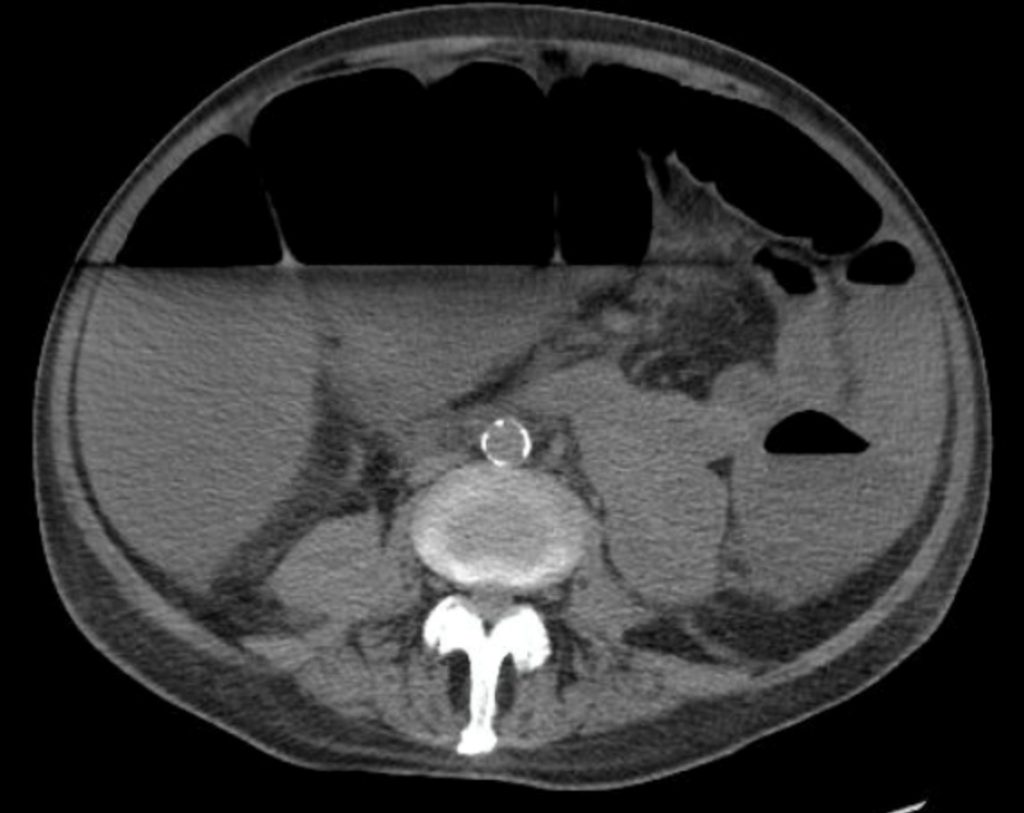67
ACR – Gastrointestinal – Acute (non-localized) Abdominal Pain and Fever
Case
Toxic Megacolon
Clinical:
History –This patient had been in the hospital for 5 days after an acute stroke. A urinary tract infection developed secondary to the urinary bladder catheter. The patient was treated with antibiotics and the bladder infection improved.
Transfer to a rehabilitation unit was completed. The patient developed intractable diarrhea and became obtunded, febrile, and seemed very unwell. General surgery was asked to assess the patient.
Symptoms – Poor historian due to stroke and diminished consciousness.
Physical – The abdomen was extremely distended. The patient was in severe pain. Bowel sounds were enhanced. There was guarding but no rebound. Skin turgor was poor suggesting dehydration.
Laboratory– The patient was hypernatremic. The urea and creatinine were elevated. The white cell count was very high. Mild macrocytic anemia was noted.
DDx:
Colitis
Abscess
Enteritis
Perforation
Imaging Recommendation
ACR – Gastrointestinal – Acute (non-localized) Abdominal Pain and Fever, Variant 3
CT Abdomen and Pelvis with Intravenous Contrast


Imaging Assessment
Findings:
Contrast could not be given intravenously due to the poor renal function. There was patchy consolidation in the lung bases and small pleural effusions. The colon was generally, massively distended. There was marked colonic wall thickening in the pelvis. No evidence of pneumatosis of the bowel or pneumoperitoneum. No evidence of obstruction.
Interpretation:
Toxic Megacolon
Diagnosis:
Clostridium Difficile Colitis
Discussion:
Toxic megacolon is the clinical term for an acute, toxic, colitis with dilatation of the colon. The dilatation can be either total or segmental. A more contemporary term for toxic megacolon is simply toxic colitis, because patients may develop toxicity without megacolon.
The hallmarks of toxic megacolon (toxic colitis), a potentially lethal condition, are non-obstructive colonic dilatation and signs of systemic toxicity.
Any of the following may predispose an individual to toxic megacolon – Dehydration, altered mental status, electrolyte abnormality, or hypotension.
TM (TC) was first thought to be a complication only of ulcerative colitis. In fact, TM (TC) may complicate any number of colitides, including inflammatory, ischemic, infectious, radiation, and pseudomembranous. Any three of the following supports the diagnosis of a toxic component – Fever (>38°C), tachycardia (>120 beats/min), leukocytosis (>10.5 x 10 3/µL), or anemia.
Imaging findings may include:
- Evidence of colonic dilatation – more than 6 cm diameter of the transverse colon, and/or 10 cm diameter of the cecum.
- Thumb printing, thickening of the bowel wall which projects into the lumen (especially the colon)
- Perforation may be focal and contained or disseminated.
- Pneumatosis intestinalis (gas bubbles in the bowel wall) may be seen
- Gas in the portal venous system is a rare, and very serious, complication.
Attributions
Figure 10.11A Supine Abdominal X-Ray of Toxic Megacolon by Dr. Brent Burbridge MD, FRCPC, University Medical Imaging Consultants, College of Medicine, University of Saskatchewan is used under a CC-BY-NC-SA 4.0 license.
Figure 10.11B Axial CT of Toxic Megacolon by Dr. Brent Burbridge MD, FRCPC, University Medical Imaging Consultants, College of Medicine, University of Saskatchewan is used under a CC-BY-NC-SA 4.0 license.
